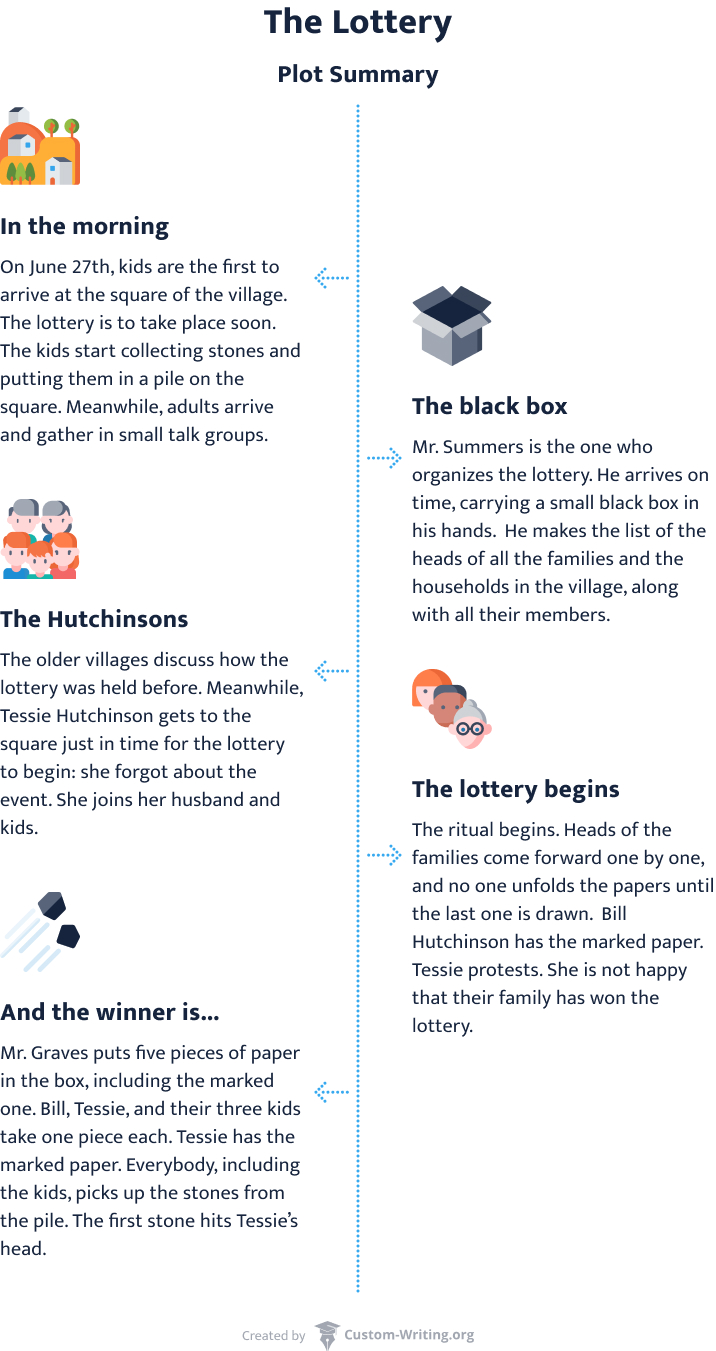A short summary of “The Lottery” comes down to a description of a pretty violent tradition of one community. Despite a quite optimistic and positive beginning, the reader will soon find out that something feels off about it. The community uses the lottery to pick one person for a sacrifice.
Looking for the summary of “The Lottery”? This Custom-Writing.org article contains everything you might need for an essay: a plot infographic and a short summary of the story by Shirley Jackson.
Let’s learn more about the story, its setting, characters, and other details with our summary!
✅ 5 Sentence Summary of The Lottery
People gather in the city square and begin preparing for a lottery – a ritual where the winner is bashed with rocks to death to ensure that “corn be heavy soon.” One of the families gets the paper with a black dot on it. This means that one of their members will be sacrificed. After another round, Tessie gets the paper with a dot. People around her pick up rocks and finish their ritual.
📈 The Lottery Plot Infographic
Below is a plot infographic of “The Lottery” by Shirley Jackson. It contains all the story’s main events.

❗ The Lottery Summary
The plot of “The Lottery” starts unfolding on June 27th, as shown on the diagram. According to the setting description, it is a beautiful morning: a sunny day, blooming flowers, and other attributes of the typical perfect summer day. The event called “the lottery” is supposed to take place soon. It doesn’t take too long here, because there are only three hundred people, unlike in other larger villages.
Kids are the first ones to arrive. They enjoy the summer and start collecting rocks. They put them in a pile on the square but keep some in their pockets. Then the adults arrive and watch the children.
Soon the men began to gather, surveying their own children, speaking of planting and rain, tractors and taxes. They stood together, away from the pile of stones in the corner, and their jokes were quiet and they smiled rather than laughed.
The Lottery, Narrator
However, it’s time to begin, so the parents call for their kids several times until the last ones finally leave the pile of rocks alone.
Mr. Summers is quick to arrive on time. There is also a brief description of this man. He appears to be volunteering to organize multiple local events such as dances and holiday celebrations. He carries a black box, and Mr. Graves, the postmaster, follows him with a stool for it.
As some villagers help Mr. Summers set the box, the readers learn some details about this tradition. It appears that the original black box was lost, but people are already used to the new one so much that they don’t want it to be replaced.
There was a story that the present box had been made with some pieces of the box that had preceded it, the one that had been constructed when the first people settled down to make a village here.
The Lottery, Narrator
Over the years, the original ritual has been forgotten, and Mr. Summers decided to change something. Now, they use pieces of paper instead of wooden pieces since it’s more convenient. Mr. Graves and Mr. Summers take the responsibility of preparing the papers the night before the lottery. Mr. Summers makes the list of the heads of all the families and the households in the village, along with all their members. He is sworn in so that it is all correctly done.
Some older villagers can remember that there used to be some elements that they don’t include anymore. Now the only thing Mr. Summers has to do is to name every person who comes up to draw the paper from the box.
There had been, also, a ritual salute, which the official of the lottery had had to use in addressing each person who came up to draw from the box, but this also had changed with time, until now it was felt necessary only for the official to speak to each person approaching.
The Lottery, Narrator
Mrs. Hutchinson, the story’s main character, gets to the square just in time for the lottery to begin. She finds Mrs. Delacroix and explains that she forgot what day it was and almost missed the event. Then she joins her husband and kids at the front, and they all joke around.
Mr. Summers decides to start so that people can go back to their duties earlier and wonders if anyone is missing. It appears that Mr. Dunbar is absent because of the broken leg, but his wife is willing to take his place. Since her son is not old enough to draw on her behalf, Mrs. Dunbar represents her whole family this year.
The last thing they check is whether the Watson boy and Old Man Warner are there. Then, it’s time for Mr. Summers to repeat the instructions even though barely anyone listens.
The people had done it so many times that they only half listened to the directions; most of them were quiet, wetting their lips, not looking around.
The Lottery, Narrator
People know the ritual very well. Heads of the families come forward when they hear their names, and no one unfolds the papers until the last one is drawn.
Steve Adams is the first one to pick the ticket. The men look pretty nervous. By this moment of “The Lottery”, you don’t have to be the best summarizer in the world to understand that the winner is not getting a nice prize.
As the process continues, Mrs. Delacroix tells Mrs. Graves that the time between the yearly lotteries is so short. It feels like the last one was only last week. Meanwhile, Mr. Adams talks to Old Man Warner about how some villages have already stopped organizing the lottery. The old man is not happy about this idea, and he is convinced it will only bring trouble.
Used to be a saying about ‘Lottery in June, corn be heavy soon.’ First thing you know, we’d all be eating stewed chickweed and acorns. There’s always been a lottery.
The Lottery, Old Man Warner
The last man has picked the piece of paper, and now it is time for the moment of truth. Everybody looks down at their tickets, and it appears that Bill Hutchinson has it. His wife, Tessie Hutchinson, can’t agree with the fairness of this lottery.
You didn’t give him time enough to take any paper he wanted. I saw you. It wasn’t fair!
The Lottery, Tessie Hutchinson
Mr. Summers asks whether there are any other households of their family. It appears that there is Hutchinson’s daughter, Eva. However, they can’t count her in because she draws with her husband. Tessie is mad and says that “it wasn’t fair” again.
Bill stops the conflict and agrees that the only other members of their family are their three kids. Mr. Graves puts five pieces of paper in the box, including the marked one, for the second round of the lottery.
As the family is ready, Mr. Summers says again that they should keep the papers folded until everybody has one. Mr. Graves has to assist Davy Hutchinson because the boy is too little to draw the slip of paper on his own. As they both come to the box, Davy laughs.
The other two children are the next. Tessie still looks angry when it’s her turn. Bill Hutchinson is the last one. Everybody is quiet. Only Old Man Warner drops a comment on how changed the lottery is nowadays, reflecting one of the story’s themes.
Mr. Summers permits to open the slips of paper. The crowd is relieved to see that the little one’s paper is blank. The other two Hutchinson kids laugh happily with their blank sheets as well. Bill doesn’t have anything on his piece, either. He has to force the one out of Tessie’s hands, to unfold it and see a large dot on it.
Now, the crowd knows what to do.
Although the villagers had forgotten the ritual and lost the original black box, they still remembered to use stones. The pile of stones the boys had made earlier was ready; there were stones on the ground with the blowing scraps of paper that had come out of the box.
The Lottery, Narrator
Everybody picks up some of the stones from the pile. Even kids are going for it, and little Davy has a couple of pebbles in his hands. Tessie is desperate and crying out that it is not fair. The first stone hits the side of her head. The ending is not as bright and shiny as the beginning.
The summary of Shirley Jackson’s “The Lottery” ends with Tessie screaming, “it isn’t right,” and the crowd approaching and overwhelming her.
✍️ The Lottery Summary Essay: How to Write
Here, you’ll find all the information about how to write a summary essay on “The Lottery.”
A summary of Jackson’s story would have the following structure:
The Lottery Summary Essay Introduction
An introduction alongside the thesis sentence gives readers all the information they need to know about “The Lottery” and its main themes. Follow these steps to write it:
- Mention the story’s title and its author.
- Introduce some of the main characters and explain what the ritual is about.
- Finalize your intro with a thesis that will serve as the main objective of your essay.
Here’s a thesis example:
Instead of blindly following the ritual, people should challenge authority and reflect on their own actions regarding what they are about to undertake.
The Lottery Summary Essay Body
The main body paragraphs should contain an essence of the episodes that can prove your point. For example, you can write that nobody tried to stop the ritual. Even Tessie’s husband remained silent and didn’t try to protest.
The Lottery Summary Essay Conclusion
The goal of the conclusion is to bring your essay together. It consists of one sentence that may restate the main argument. For instance, you can summarize your thesis by saying that people often follow herd behavior, and it can be challenging to fight social pressure.
Need some assistance? Use our conclusion generator: it will help you write a perfect final paragraph.
Note that the summary is not a direct copy of the original text. The goal is to retell the story in your own words. Also, it’s vital that you don’t stray away from the original ideas and don’t add anything that is not in the story.
We hope that the above summary is useful. If you’re looking for more information on the story, please read the Analysis and Essay Ideas sections.











